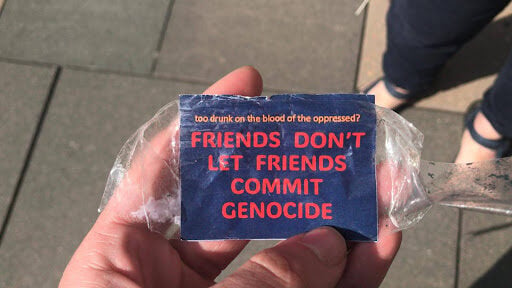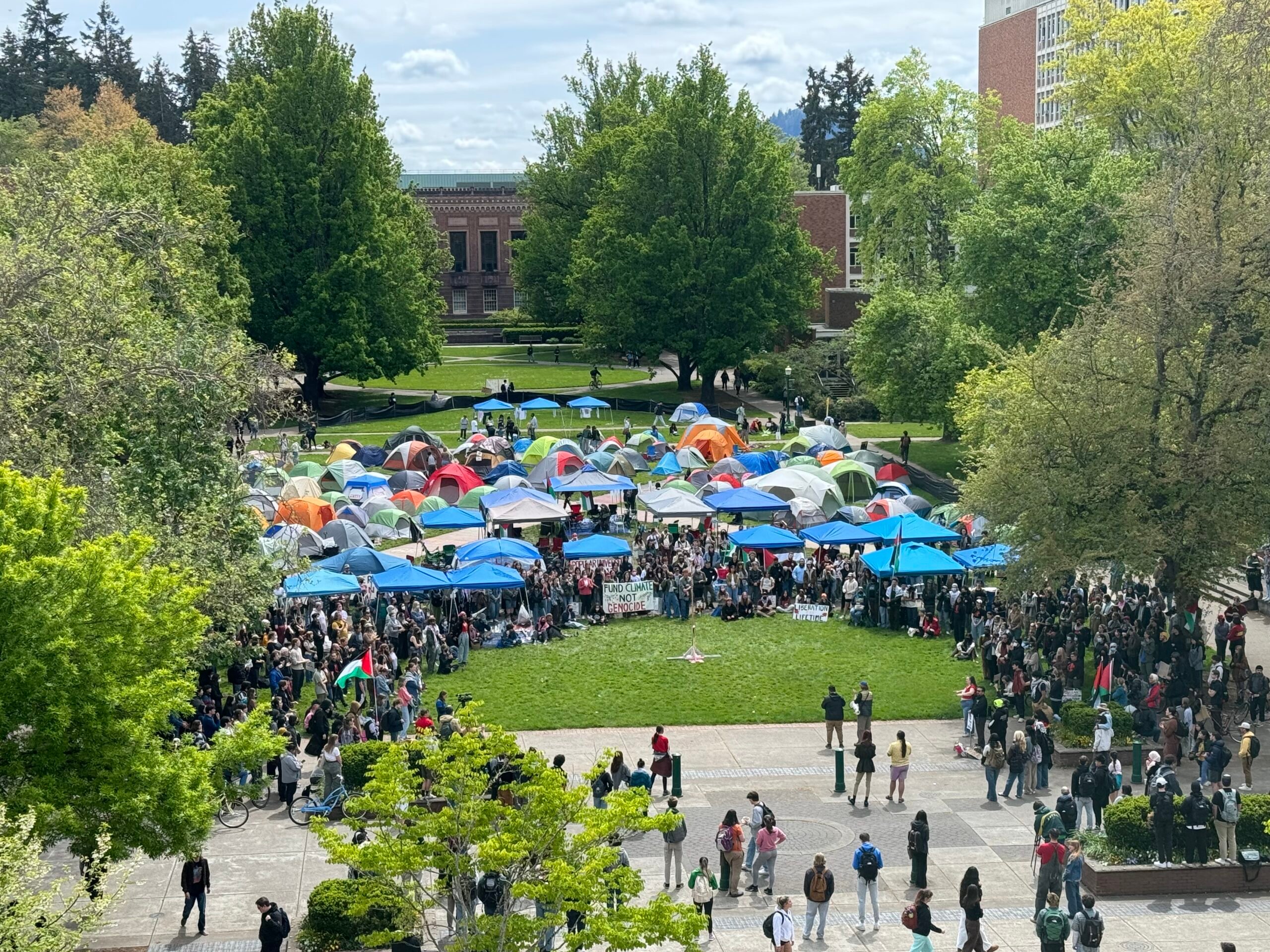
Teaneck’s new avant garde eatery seeks to reimagine the traditional Pesach seder.
Food trends in the kosher world tend to lag about 10 years behind those in the non-kosher world. So, it is somehow not surprising, nearly seven years after Chef Ferran Adrià closed his world-famous restaurant, elBulli—which the Guardian’s John Carlin once described as “the most imaginative generator of haute cuisine on the planet,” and which numerous critics had named “the high temple of molecular gastronomy”—that Teaneck should become home to the first kosher haute cuisine restaurant devoted wholly to molecular gastronomy.
The new restaurant, Molekulah, is located on Queen Anne Road, directly behind the Exxon Station at the corner of West Englewood Avenue. This new 25-seat eatery has a starkly modern decor (of the sort that was popular in avant garde restaurants a decade ago), with white walls, bright lighting and chromed furniture and fixtures. The nondescript brick exterior is embellished only by a simple, stark, black and white sign with the name Molekulah written in both Hebrew and English. The mezuzah is illuminated with an ever-changing array of hologram portraits of early leaders of the French Foreign Legion, one of the chef’s primary influences.
Even before it opens, Molekulah has been the subject of a great deal of excitement in the Jewish press. (Elan Kornblum of Great Kosher Restaurants Magazine, for example, has given Molekulah more ink is his newsletter—not to mention his Facebook page—than most restaurants receive after 10 years in business.) Last week, after a great deal of pestering—and the offer of my last bottle of the kosher 1999 Chateau Smith Haul Lafitte—I had the opportunity to visit Molekulah while it was still undergoing renovations and speak to the owner Chef Jonathan Framkind, a Tenafly native and a longtime veteran of Miami’s kosher restaurant scene, about his new restaurant, and about his fascinating life.
Framkind embarked on one of the most circuitous routes to becoming a kosher chef that I have ever heard, and I’ve heard a lot of stories about a lot of people ending up working in kosher food, if you know what I mean. “When I graduated from Tenafly High School, I really wanted to get away from my suburban life, but was unsure what to do. One night a friend and I rented a tape of a Jean-Claude Van Damme movie about the French Foreign Legion… the next day I was making overseas calls to France to find out how to enlist,” explained Framkind. A week later, he was in Brazil, busking in the Rio subway with his Jewish a cappella group to earn enough money to fly to France.
“I joined the legion to be a soldier, but within six months of basic training in sharpshooter training, ordnance management and explosives detection, I found myself working in the base kitchen in Aubagne just outside of Marseille. I knew nothing about food when I joined the legion, but the legion taught me how to cook; the Provençal restaurant scene taught me how to eat,” he said, wiping a tear away with a corner of the white scarf he wore jauntily around his neck.
After serving four years in the foreign legion, Framkind moved to Paris in order to study at Le Cordon Bleu. “If the legion taught me to cook, the Cordon Bleu taught me to be a chef, which is not about cooking at all, but about yelling and explaining to underlings who is in charge,” said Framkin. It was while living in Paris that Framkind met his future wife, Rachel, and started becoming religiously observant. “Rachel taught me to appreciate my religion as a way of dealing with all the screaming I had to do at work. Within a few months of meeting her, I was keeping kosher and putting on tefillin, and a few months later we were standing under the chuppah together,” says Framkind.
“At our wedding, one of Rachel’s American cousins mentioned that he was looking for a chef for his new kosher fine-dining project in Miami. While the restaurant closed three days before it was supposed to open, there was still plenty of work for a classically trained kosher chef in Miami.”
Recently, after years of working for others, Framkind moved back to his native Bergen County to open Molekulah, his own restaurant. “The commercial rent in Teaneck,” explains Framkind, “is about half of what it is in Miami Beach, but the kosher clientele is every bit as sophisticated.” After a beat, he added, “Plus my parents just retired to Florida, so for us it seemed like a good time to move.”
Framkind says that the focus of Molekulah’s menu will be molecular gastronomy, a school of cooking that uses techniques and chemicals from the chemistry lab to innovate in the kitchen. “For the past few years I have been fascinated by the possibilities for molecular gastronomy in kosher cooking. I had been flipping through a chefs’ catalog and noticed that many of the chemicals for MG [molecular gastronomy] were advertised as kosher… so I went to Barcelona to really learn how to do MG well.” In Barcelona, he spent three months studying with Chef Andre Rentaplats, who, says Framkind, “had been the head dishwasher at elBulli, and really knows all of MG’s dirty little secrets.”
While originally scheduled to open in January, due to construction and mob-related delays (primarily from Great Kosher Restaurant foodies starting rumors on their Facebook page), the restaurant is now scheduled to open at the end of March, on the first night of Passover. “Once we realized we would not be able to open until March anyway we figured that we might as well wait and open on Passover,” he said, noting he was looking forward to wowing his guests with a multi-course seder experience, the likes of which no one has ever seen.
“A molecular gastronomy seder raises some really unique possibilities,” said Framkind. “Besides, the petrochemicals I use in cooking are neither plant- nor animal-derived, so there are not any problems in using them on Pesach.” During my visit, Framkind was honing his menu for the seder, and offered me samples of some of the dishes he plans the serve.
The first thing I tried was Framkind’s “Reimagined Charoses.” He handed me a bowl with a clear substance derived of walnuts, filled with tiny, purple, caviar-sized spheres containing cinnamon-infused Kedem Extra Heavy Malaga. This cement-like putty with purple orbs was all covered with a white powder made from liquid nitrogen-frozen-and-ground Granny Smith apples. While the appearance was a bit off-putting, the flavor was none other than of traditional Ashkenazi charoses. “I wanted to shock with this charoses… [and] show that everyday flavors can come with exotic appearances.”
The next thing I tried was his maror, which he made in the form of a fruit-rollup-like, ground horseradish leather, which was cut with a scalpel into root shapes. The maror was intensely hot (probably too hot for most) yet flavorful. Interestingly, while Framkind and I were discussing the maror, Rabbi Steven Pruzansky, who was visiting Molekulah for a pre-opening inspection, wandered over to our table and tried a piece of horseradish leather. After turning beet red, breaking out in a cold sweat and coughing for a few minutes, Rabbi Pruzansky managed to gasp, “now that’s maror! I’m going to post on my blog about this!”
When I, myself, had recovered sufficiently from the maror by running outside, buying and gulping a Diet Coke at the Exxon station (non-alcoholic beverages at Molekulah are only available in hydrogenated form), we moved on to the fish course, “Herring and Smoked-Tongue Balls.” This surprisingly enjoyable dish consists of thinly sliced schmaltz herring fillets dipped in margarine infused with dried, powdered dulse, a seaweed Framkind said he can’t find kosher-certified, so he collected it himself off the coast of Ireland, gathering it from near the rocks at the bottom of the tide. The herring was wrapped around an edible, cellophane-like, golf-sized ball of smoke, all held together by a net made of finely julienned pickled onions. “When you bite into the ball, the edible cellophane breaks apart, releasing about two milliliters of alder-wood smoke into your mouth. The smoked tongue is your own,” says Framkind. I was so moved I actually fell off my chair.
After returning from the Exxon to get ice for my bruised legs, I was ready to move on to Framkind’s “Deconstructed Matzoh Ball Soup.” Served on a small square plate, it consisted of a half-inch strip of poached chicken breast, surrounded by nitrous oxide-whipped islands of Matzoh ball fluff, accompanied with a shot-glass-size chaser of hot carrot- and onion-infused salt water served in a demitasse cup. “All the elements of matzoh ball soup are there, but it is an entirely different eating experience, and one that makes you truly appreciate all of the elements of the soup,” explains Framkind. “By denying the guest a traditional soup experience, they find they miss it,” he added, noting that he felt his appearance in the neighborhood would add to other restaurants’ success, as most of them have “traditional” soup on their menus.
The last dish we tried was the entrée, which he simply called “sous vide surprise.” One of the sous chefs brought out a vacuum-packed pouch, with a kidney shaped piece of light-pink colored meat, with a bit of liquid around it. The sous chef placed a plate in front of me, carefully cut the bag open with a pen knife, and gently poured the meat and liquid onto my plate. “I like to open the pouch tableside so that the diner does not miss any of the aromatics coming from the pouch,” explained Framkind. The aroma was of stewed figs and prunes with a hint of carrot; the meat was a succulent kidney, stuffed with caramelized carrot tsimmes. “The secret is to let the meat cook with the tsimmes stuffed inside it. After 36 hours at 144 degrees F, the meat is so delightfully flavored by the caramelized carrots, not the mention how the figs and prunes flavor the liquid that we add to the pouch,” bragged Framkind. “Plus, I read a lot of articles in The Jewish Link about how much Teaneckers like kidneys,” he said. I didn’t bother to explain.
Framkind would tell me nothing of the dessert, which he insisted needed to be a total surprise. However, after I finished my veal (and stopped licking the plate when nobody was looking), Framkind asked me to look over his wine list and let him know what I thought. It was a nice list of mainly French and Californian wines, but what caught my attention was the “housemade non-alcoholic ‘Champagne.’” Framkind got up and brought back an old-fashioned soda syphon that was apparently filled with the ‘Champagne,’ and filled my wine glass with some of the liquid. “I make it with Kedem white grape juice,” explained Framkind. “Then I add in citric acid, malic acid, cream of tartar and gypsum, and charge it with CO2.” While no one would be fooled into thinking it was Champagne, it might pass as a cheap Prosecco.
At this point I got the distinct impression that it was time for me to go. So, I took the bottle of Smith Haut Lafitte out of my briefcase and, with a tear in my own eye, handed it to Framkind and left.
Given that Molekulah’s molecular gastronomy menu is so labor intensive that it requires Framkind to employ eight chefs, 12 sous chefs and a chemist to serve a 25-seat dining room, it seems unlikely the it is destined to stay open long. For the time being though, Molekulah is sure to be a beacon for the (affluent) kosher foodies in New Jersey and New York.
The maitre d’ told me that the seders—both of which are sold out—cost $990 per person (55 Chai) plus wine, except for the 10 lucky people who got the $19.95 Groupon. There are, however, spots available for Chol Hamoed. For information or to make a reservation email [email protected], who extends his fondest wish for everyone to have a happy Purim.
By Gamliel Kronemer












